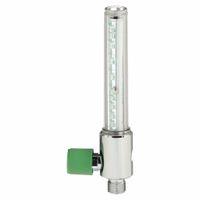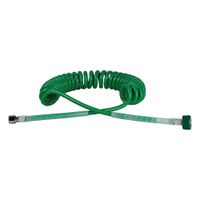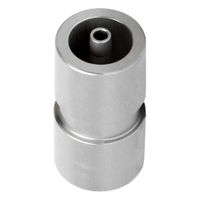Call +(254) 703 030 000 / 751 483 999 / 721 704 777
- Home
- Safety
- Medical Supplies Equipment
- Airway Opening Oxygen Delivery Equipment
- Medical Gas Delivery
.....Read More
Frequently Asked Questions
What are the types of medical gases used in hospitals?
1. **Oxygen (O2):** Essential for respiratory therapy, oxygen is used to treat patients with respiratory distress, hypoxemia, and other conditions requiring supplemental oxygen.
2. **Nitrous Oxide (N2O):** Commonly known as "laughing gas," it is used for its anesthetic and analgesic effects, often in dental procedures and during childbirth.
3. **Medical Air:** A mixture of nitrogen and oxygen, medical air is used in respiratory therapy and as a carrier gas for anesthetics. It is free from contaminants and moisture.
4. **Carbon Dioxide (CO2):** Used in insufflation during laparoscopic surgeries to create a working space in the abdomen. It is also used in some respiratory therapies and laboratory procedures.
5. **Nitrogen (N2):** Used to power surgical tools and as a cryogenic agent for preserving biological samples and tissues.
6. **Helium (He):** Often mixed with oxygen to create heliox, which is used to treat patients with airway obstructions due to its low density, allowing easier breathing.
7. **Entonox:** A 50/50 mixture of nitrous oxide and oxygen, used for pain relief during labor and minor surgical procedures.
8. **Medical Vacuum:** Not a gas, but an essential part of the medical gas system, used to remove fluids and gases from patients during surgery and other medical procedures.
9. **Anesthetic Gases:** Various volatile anesthetic agents like sevoflurane, isoflurane, and desflurane are used to induce and maintain anesthesia during surgeries.
10. **Specialty Gases:** These include a variety of gases used for specific medical and laboratory applications, such as calibration gases for medical equipment.
How do medical gas flow measurement devices work?
Medical gas flow measurement devices work by quantifying the flow rate of gases used in medical settings, such as oxygen, nitrous oxide, and air. These devices ensure accurate delivery of gases to patients, which is crucial for effective treatment and safety.
1. **Flow Sensors**: These devices often use flow sensors that detect the rate of gas flow. Common types include:
- **Rotameters**: Utilize a float within a tapered tube. As gas flows, it lifts the float to a level that corresponds to the flow rate, which can be read on a calibrated scale.
- **Thermal Mass Flow Meters**: Measure the heat loss from a heated element as gas flows over it. The rate of heat loss is proportional to the mass flow rate of the gas.
- **Ultrasonic Flow Meters**: Use sound waves to measure the velocity of gas flow. The time it takes for sound waves to travel between sensors is used to calculate flow rate.
2. **Pressure Differential Devices**: These measure the pressure drop across a restriction in the flow path, such as an orifice or a venturi tube. The pressure difference is proportional to the flow rate.
3. **Electronic Flow Meters**: Incorporate sensors and digital displays to provide precise flow measurements. They often include alarms and data logging for enhanced monitoring.
4. **Calibration and Standards**: Devices are calibrated against known standards to ensure accuracy. Regular maintenance and calibration are essential to maintain precision.
5. **Safety Features**: Many devices include safety features like alarms for flow deviations, ensuring that any discrepancies in gas delivery are promptly addressed.
These devices are integral to patient care, providing reliable and accurate measurements to support various medical procedures and treatments.
What is the importance of medical gas analyzers and sensors?
Medical gas analyzers and sensors are crucial in healthcare settings for ensuring patient safety and effective treatment. They monitor and measure the concentration of gases such as oxygen, carbon dioxide, nitrous oxide, and anesthetic agents in medical environments. Accurate monitoring is vital for maintaining the correct therapeutic levels, preventing hypoxia or hyperoxia, and ensuring the safe administration of anesthesia.
In critical care and surgical settings, these devices help in real-time monitoring of respiratory gases, allowing for immediate adjustments to ventilation and anesthesia delivery. This is essential for patient safety, as incorrect gas concentrations can lead to severe complications or even fatalities.
Medical gas analyzers and sensors also play a significant role in equipment maintenance and compliance with health regulations. They ensure that medical gas delivery systems are functioning correctly and that gas purity meets the required standards. This is important for preventing contamination and ensuring the reliability of life-support systems.
Furthermore, these devices contribute to cost efficiency by optimizing gas usage and reducing waste. By providing precise measurements, they help in the efficient management of gas supplies, which is economically beneficial for healthcare facilities.
In summary, medical gas analyzers and sensors are indispensable for patient safety, regulatory compliance, equipment maintenance, and cost management in healthcare settings. Their role in ensuring accurate gas delivery and monitoring is critical for effective patient care and operational efficiency.
How do air-oxygen mixers and blenders function?
Air-oxygen mixers and blenders function by combining ambient air with pure oxygen to deliver a precise oxygen concentration to patients. These devices are crucial in medical settings, particularly in respiratory therapy and anesthesia, where controlled oxygen delivery is essential.
The basic operation involves two primary components: a proportioning valve and a mixing chamber. The proportioning valve regulates the flow rates of both air and oxygen. By adjusting these flow rates, the device can achieve the desired oxygen concentration. The valve settings are typically calibrated to allow for a range of oxygen concentrations, often between 21% (room air) and 100% (pure oxygen).
Once the air and oxygen pass through the proportioning valve, they enter the mixing chamber. Here, the gases are thoroughly mixed to ensure a consistent and homogenous blend. The mixed gas is then delivered to the patient through a delivery system, such as a mask or nasal cannula.
Many air-oxygen mixers and blenders are equipped with a built-in oxygen analyzer. This feature continuously monitors the oxygen concentration of the output gas, providing real-time feedback and ensuring accuracy. Alarms may be included to alert healthcare providers if the oxygen concentration deviates from the set range.
These devices are designed to be user-friendly, with clear controls and displays for easy adjustment and monitoring. They are also built to maintain consistent performance under varying conditions, such as changes in temperature or pressure, ensuring reliable operation in diverse clinical environments.
What are the common issues with medical gas delivery systems?
Common issues with medical gas delivery systems include:
1. **Leaks**: Gas leaks can occur due to faulty connections, worn-out seals, or damaged pipes, leading to wastage and potential safety hazards.
2. **Contamination**: Impurities or microbial contamination in the gas supply can compromise patient safety and treatment efficacy.
3. **Pressure Irregularities**: Inconsistent pressure can affect the delivery of gases, impacting patient care and equipment functionality.
4. **Equipment Malfunction**: Faulty valves, regulators, or flow meters can disrupt the accurate delivery of gases.
5. **Inadequate Maintenance**: Poor maintenance practices can lead to system failures, leaks, and contamination.
6. **Improper Installation**: Incorrect installation of pipes and equipment can result in operational inefficiencies and safety risks.
7. **Aging Infrastructure**: Older systems may suffer from wear and tear, leading to increased risk of failure and inefficiency.
8. **Human Error**: Mistakes in handling or operating the system can lead to incorrect gas delivery or system damage.
9. **Alarm Failures**: Malfunctioning alarms can fail to alert staff to issues like low pressure or leaks, delaying response times.
10. **Supply Chain Issues**: Delays or shortages in gas supply can disrupt hospital operations and patient care.
11. **Regulatory Non-compliance**: Failure to adhere to safety and operational standards can result in legal and safety issues.
12. **Cross-connection**: Incorrect connections between different gas lines can lead to dangerous gas mixtures being delivered.
13. **Inadequate Training**: Lack of proper training for staff can lead to misuse or mishandling of the system.
Addressing these issues requires regular maintenance, proper training, adherence to safety standards, and timely upgrades to infrastructure.
How do you maintain and service medical gas equipment?
To maintain and service medical gas equipment, follow these steps:
1. **Regular Inspections**: Conduct routine inspections to check for leaks, pressure levels, and overall system integrity. Use leak detection solutions or electronic detectors.
2. **Preventive Maintenance**: Schedule regular maintenance based on manufacturer guidelines. This includes cleaning, lubricating, and replacing worn parts.
3. **Calibration**: Ensure all gauges and sensors are calibrated regularly to maintain accuracy in gas delivery.
4. **Filter Replacement**: Replace filters as per the recommended schedule to prevent contamination and ensure efficient operation.
5. **Check Connections**: Inspect all connections, hoses, and fittings for wear and tear. Tighten or replace as necessary to prevent leaks.
6. **Alarm Systems**: Test alarm systems to ensure they are functioning correctly. This includes both visual and audible alarms.
7. **Documentation**: Keep detailed records of all maintenance activities, inspections, and repairs for compliance and future reference.
8. **Training**: Ensure that all personnel involved in the maintenance and operation of medical gas equipment are properly trained and certified.
9. **Emergency Protocols**: Establish and regularly review emergency protocols for gas supply failure or equipment malfunction.
10. **Compliance**: Adhere to all relevant standards and regulations, such as those from NFPA, ISO, or local health authorities.
11. **System Testing**: Perform periodic system tests to ensure all components are working together effectively.
12. **Backup Systems**: Regularly check and maintain backup systems to ensure they are ready for use in case of primary system failure.
13. **Ventilation**: Ensure proper ventilation in areas where medical gases are stored and used to prevent accumulation of gases.
By following these steps, you can ensure the safe and efficient operation of medical gas equipment.
What safety precautions are necessary when handling medical gases?
When handling medical gases, several safety precautions are essential to ensure the safety of both healthcare providers and patients:
1. **Proper Storage**: Store cylinders in a well-ventilated, dry area away from heat sources. Secure them upright with chains or straps to prevent tipping.
2. **Labeling**: Ensure all cylinders are clearly labeled with the gas type and associated hazards. Never use a cylinder without a label.
3. **Handling**: Use appropriate trolleys or carts for transportation. Avoid dragging, dropping, or rolling cylinders to prevent damage.
4. **Personal Protective Equipment (PPE)**: Wear appropriate PPE, such as gloves and eye protection, to prevent injury during handling.
5. **Training**: Ensure all personnel handling medical gases are adequately trained in their use, potential hazards, and emergency procedures.
6. **Leak Detection**: Regularly check for leaks using soapy water or approved leak detection solutions. Never use a flame to check for leaks.
7. **Ventilation**: Ensure adequate ventilation in areas where gases are used to prevent accumulation and potential asphyxiation.
8. **No Smoking or Open Flames**: Prohibit smoking and open flames in areas where medical gases are stored or used to prevent fire hazards.
9. **Regulator Use**: Use the correct regulator for each gas type. Inspect regulators and connections for damage before use.
10. **Emergency Procedures**: Have clear emergency procedures in place, including evacuation plans and access to safety data sheets (SDS) for each gas.
11. **Pressure Relief**: Ensure cylinders have pressure relief devices to prevent over-pressurization.
12. **Regular Maintenance**: Conduct regular maintenance and inspections of gas delivery systems and equipment to ensure proper functioning.
By adhering to these precautions, the risks associated with handling medical gases can be significantly minimized, ensuring a safe environment for both healthcare workers and patients.




